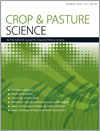Dual-purpose canola (Brassica napus) describes the use of a canola crop for grazed winter forage before seed production, a practice that has only recently been developed in southern Australia. Long-season winter canola has been grazed without yield penalty in higher rainfall zones of Australia (>650 mm) and the USA, but the potential areas are small. The feasibility to graze spring canola varieties across wider areas of the medium-rainfall (450–650 mm), mixed-farming zone in Australia is therefore of interest. We conducted a series of six field experiments involving a range of canola cultivars and grazing management and agronomy systems from 2007 to 2009 at Young in southern New South Wales, Australia, to determine the feasibility of and refine the principles for grazing dual-purpose spring canola without significant yield penalty. Mid-season, Australian spring canola cultivars including conventional and hybrid varieties representing a range of herbicide tolerance (triazine-tolerant, Clearfield®, and Roundup Ready®) were sown from 16 April to 12 May and grazed with sheep at a range of growth stages from early vegetative (June) to mid-flowering (September). In general, early-sown crops (sown mid-April) provided significant grazing (∼800 dry sheep equivalent grazing days/ha) in winter before bud elongation, and recovered with no impact on grain yield or oil content. As previously reported, yield was significantly reduced (by up to 1 t/ha) when grazing occurred after buds had elongated (late July), due to the delayed flowering associated with bud removal by sheep and insufficient time for biomass and yield recovery. However, yield was also reduced in crops grazed before bud elongation if insufficient residual biomass remained (<1.0 t/ha for late July lock-up) to facilitate crop recovery even when there was little delay in crop development. We suggest that refinements to the existing ‘phenology-based’ grazing recommendations would assist to avoid yield loss in grazed spring varieties, and propose three grazing stages (safe, sensitive, and unsafe) that integrate the impacts of time, crop growth stage, residual biomass, and seasonal conditions to avoid yield loss under different circumstances. Such refinements to reduce the likelihood of grazing-induced yield loss would provide more confidence for mixed farmers to maximise the benefits from dual-purpose canola in different environments. Based on the outcomes of these experiments, dual-purpose spring canola is likely to have significant potential for wider application in other mixed farming zones, with similar region-specific refinements based on the principles reported here.
How to translate text using browser tools
16 July 2012
Refining crop and livestock management for dual-purpose spring canola (Brassica napus)
J. A. Kirkegaard,
S. J. Sprague,
P. J. Hamblin,
J. M. Graham,
J. M. Lilley
ACCESS THE FULL ARTICLE

Crop and Pasture Science
Vol. 63 • No. 5
August 2012
Vol. 63 • No. 5
August 2012
feed gap
grazing crops
mixed farm
rapeseed
sheep




